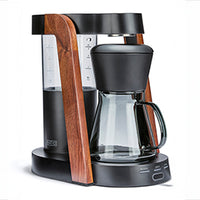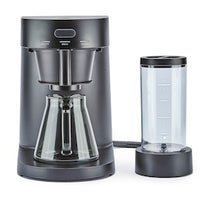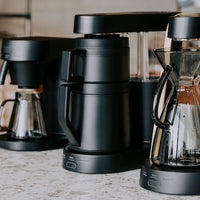How Do You Know If You’re Over-Extracting Your Coffee?
Key Takeaways
- Over-extraction of coffee results in a bitter, unpleasant taste.
- Common causes include too fine a grind, extended brewing time, and incorrect water temperature.
- Adjusting variables like grind size and brewing time can balance flavor.
- Experimenting with coffee-to-water ratios refines taste and strength.
- Tasting and methodical adjustments improve your coffee-making skills.
Over-extraction happens when you brew your coffee too long, resulting in a bitter, harsh taste that is unmistakable to the palate. You might notice that your coffee has an astringent mouthfeel, akin to the sensation of sucking on a dry lemon. This bitterness is a telltale sign that you've extracted more than desired from your coffee grounds. Utilizing the right coffee brewing techniques is essential to achieve a balanced extraction. The coffee flavor wheel can help you identify which notes are overpowering, leading to this undesirable taste. Pay attention to brewing time and grind size to perfect your coffee extraction process.

Signs of Over Extracted Coffee
One unmistakable sign of over-extracted coffee is its overwhelmingly bitter taste. This bitterness is often joined by a dry, scratchy mouthfeel that makes the coffee uncomfortable to drink. Rather than the delightful notes visible on a coffee flavor wheel, such as chocolate or caramel, over-extraction brings out the least desirable attributes.
Another sign to watch out for is a lingering unpleasant aftertaste that coats your tongue. If you detect an acerbic quality post-sip, you’re likely dealing with coffee extraction that's gone too far. It tends to overshadow the nuanced flavors you aim to enjoy in a good cup of coffee.
An adjustment in the grind size can often alleviate these undesirable traits. Using a finer grind in press-based brewing or a coarser grind for espresso might just hit the spot. Consider revisiting your coffee brewing techniques; a simple tweak might transform your bitter cup into a balanced brew.
To make the most out of understanding over-extraction, try experimenting with the brewing time. Reducing the time coffee and water interact can significantly improve flavor, leading to a more satisfying and pleasant coffee experience. This proactive approach can help you get closer to that perfect cup.
Common Causes of Over Extraction
Consistently using too fine a grind is one common cause of over-extraction in coffee. When coffee grounds are too fine, they create a large surface area, allowing water to extract flavors more rapidly and intensely. This often results in a cup that is bitter and overly strong, diverging significantly from the desired taste profile laid out on the coffee flavor wheel.
Brewing time significantly affects extraction levels. Extending the time during which water interacts with ground coffee increases the likelihood of over-extraction. Aiming for a balanced brew, monitoring brewing time can ensure you don’t veer into bitter territory. Efficient coffee brewing techniques can help manage time and prevent unwanted flavor notes.
Water temperature plays a crucial role in the coffee extraction process. Too hot a temperature can cause over-extraction, leading to a taste that is harsh and acrid. For example, brewing with nearly boiling water in a French press can scorch the grounds. It is crucial to maintain an optimal temperature range between 195°F and 205°F to achieve a harmonious cup.
The coffee-to-water ratio also impacts the extraction process. Using too little coffee in proportion to the water can lead to an imbalance, forcing the water to extract more than it should from the grounds. Keeping track of this ratio ensures you extract a pleasant and flavorful coffee consistently, staying faithful to techniques that enhance the coffee experience.
For a seamless coffee experience, store coffee beans properly before brewing. Stale coffee can lead to uneven extraction since old beans tend to extract more harsh flavors. Proper storage retains bean freshness, locking in desirable qualities showcased in the coffee flavor wheel, enriching your daily cup ritual.

Adjusting Your Brewing Technique
To achieve the perfect balance in your cup, adjusting your brewing technique can make a significant difference. By focusing on variables like grind size, you can avoid over-extracting your coffee. Slightly coarser grounds reduce the surface area exposed to water, minimizing the risk of extracting undesirable bitter flavors. This adjustment helps maintain the integrity of the more pleasant notes identified on the coffee flavor wheel.
Using brewing time effectively is another crucial step in refining technique. Experimenting with shorter brewing durations prevents over-extraction by limiting the extent to which flavors are pulled from the coffee grounds. Employ timers to familiarize yourself with the exact time needed for a balanced brew, ensuring each cup mirrors the flavors you desire, free from harshness.
Temperature adjustments can vastly improve the quality of your coffee. Maintaining a water temperature between 195°F and 205°F is optimal for a flavorful cup. Using a thermometer can help gauge the temperature accurately, allowing you to remain within the ideal range that promotes balanced coffee extraction. This can prevent brewing errors that might otherwise lead to over-extraction.

Experimenting with Ratios
How does adjusting ratios impact your coffee’s flavor profile? By experimenting with different coffee-to-water ratios, you can significantly influence the taste, strength, and overall experience of your brew. A balanced ratio ensures that flavors are just right—neither too weak nor overwhelmingly bitter. Playing with these variables allows you to tailor each cup, avoiding the pitfalls of over-extraction while savoring the diverse notes showcased by the coffee flavor wheel.
Understanding the coffee flavor wheel can guide your experimentation with ratios. By tweaking your current calculations, you might discover nuances that were previously masked by overpowering bitterness. A typical starting point might be 1:15 or 1:16 (coffee to water). These ratios lend themselves to a well-rounded flavor. Adjusting this balance can lend insight into how subtle shifts yield varying strengths and complexities in flavor.
To master the art of coffee brewing techniques, consider measuring your coffee and water precisely. Using a digital scale enhances accuracy, down to the gram. This simple yet effective method allows you to keep track of changes, helping you document what ratios work best. As you perfect this precision, you'll move closer to understanding the optimal balance for your taste.
Another technique is to try different ratios across various brewing methods, such as French press, espresso, or pour-over. These coffee brewing techniques each interact uniquely with your chosen ratios. You may find that your perfect espresso ratio is notably different from what you prefer in a French press. This versatility not only enhances your coffee extraction process but broadens your appreciation of coffee’s potential.
Consistent experimentation with ratios helps build a personal log of what truly delights you. This evolving journey through coffee begins to overlap with the science of coffee extraction, surrounded by the art of the flavor wheel. As you continue adjusting and tasting, you’ll find your preference emerge, turning every cup into a tailored experience.

Tasting and Adjusting
Tasting your coffee is an essential step in identifying over-extraction. By carefully analyzing the flavors in each sip, you can determine whether bitterness or astringency is present. This sensory evaluation can guide adjustments to your brewing process, leading you towards the balanced flavors depicted on the coffee flavor wheel. Approach each tasting session with an open mind to detect subtle differences.
To truly understand the nuances of coffee extraction, shift your mindset from merely following recipes to exploring and experimenting with taste. This change from rigid adherence to intuitive understanding allows you to connect more deeply with your coffee's unique complexities. With this perspective, you gain confidence in tweaking your methods based on how flavors present themselves during tasting.
After tasting, adjust your brewing technique to address any detected imbalances. If the taste is bitter, consider shortening the brewing time or coarsening the grind size. Altering each variable provides insight into how these factors contribute to the overall extraction. This iterative process not only refines the flavor but also enhances your skill in crafting the perfect cup of coffee.
Documenting each tasting and adjustment ensures that you track progress and refine your approach. Create a tasting journal to annotate changes in variables and their corresponding flavor impacts. This method of systematic tasting and adjusting builds your knowledge and comfort level, helping you navigate coffee brewing techniques with precision and intent.
Frequently Asked Questions
What is over-extraction in coffee?
Over-extraction occurs when coffee grounds interact with water for too long, leading to a bitter and harsh flavor.
How can I avoid over-extracting my coffee?
Adjusting grind size, brewing time, and water temperature can help prevent over-extraction.
How does grind size affect coffee extraction?
A finer grind increases surface area, often leading to over-extraction, while a coarser grind can prevent it.
What are ideal water temperature ranges for brewing coffee?
The optimal water temperature for coffee brewing is between 195°F and 205°F.
Is a bitter taste always a sign of over-extraction?
Yes, a bitter taste typically indicates over-extraction, as this process draws out the harshest compounds from the coffee grounds.
 Ratio Eight S2
Ratio Eight S2
 Ratio Eight Original
Ratio Eight Original
 Ratio Six
Ratio Six
 Ratio Four
Ratio Four
 Compare Machines
Compare Machines






